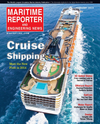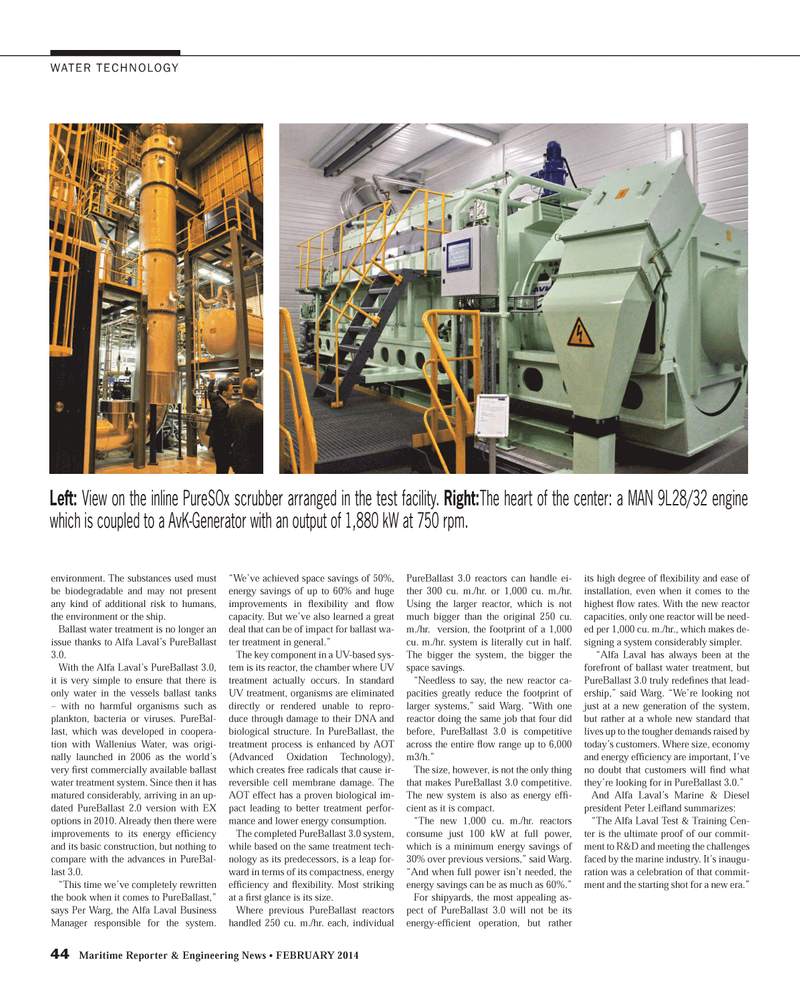
Page 44: of Maritime Reporter Magazine (February 2014)
Cruise Shipping Edition
Read this page in Pdf, Flash or Html5 edition of February 2014 Maritime Reporter Magazine
44 Maritime Reporter & Engineering News • FEBRUARY 2014
WATER TECHNOLOGY environment. The substances used must be biodegradable and may not present any kind of additional risk to humans, the environment or the ship.
Ballast water treatment is no longer an issue thanks to Alfa Laval’s PureBallast 3.0.
With the Alfa Laval’s PureBallast 3.0, it is very simple to ensure that there is only water in the vessels ballast tanks – with no harmful organisms such as plankton, bacteria or viruses. PureBal- last, which was developed in coopera- tion with Wallenius Water, was origi- nally launched in 2006 as the world’s very fi rst commercially available ballast water treatment system. Since then it has matured considerably, arriving in an up- dated PureBallast 2.0 version with EX options in 2010. Already then there were improvements to its energy effi ciency and its basic construction, but nothing to compare with the advances in PureBal- last 3.0. “This time we’ve completely rewritten the book when it comes to PureBallast,” says Per Warg, the Alfa Laval Business
Manager responsible for the system. “We’ve achieved space savings of 50%, energy savings of up to 60% and huge improvements in fl exibility and fl ow capacity. But we’ve also learned a great deal that can be of impact for ballast wa- ter treatment in general.”
The key component in a UV-based sys- tem is its reactor, the chamber where UV treatment actually occurs. In standard
UV treatment, organisms are eliminated directly or rendered unable to repro- duce through damage to their DNA and biological structure. In PureBallast, the treatment process is enhanced by AOT (Advanced Oxidation Technology), which creates free radicals that cause ir- reversible cell membrane damage. The
AOT effect has a proven biological im- pact leading to better treatment perfor- mance and lower energy consumption.
The completed PureBallast 3.0 system, while based on the same treatment tech- nology as its predecessors, is a leap for- ward in terms of its compactness, energy effi ciency and fl exibility. Most striking at a fi rst glance is its size.
Where previous PureBallast reactors handled 250 cu. m./hr. each, individual
PureBallast 3.0 reactors can handle ei- ther 300 cu. m./hr. or 1,000 cu. m./hr.
Using the larger reactor, which is not much bigger than the original 250 cu. m./hr. version, the footprint of a 1,000 cu. m./hr. system is literally cut in half.
The bigger the system, the bigger the space savings. “Needless to say, the new reactor ca- pacities greatly reduce the footprint of larger systems,” said Warg. “With one reactor doing the same job that four did before, PureBallast 3.0 is competitive across the entire fl ow range up to 6,000 m3/h.”
The size, however, is not the only thing that makes PureBallast 3.0 competitive.
The new system is also as energy effi - cient as it is compact. “The new 1,000 cu. m./hr. reactors consume just 100 kW at full power, which is a minimum energy savings of 30% over previous versions,” said Warg. “And when full power isn’t needed, the energy savings can be as much as 60%.”
For shipyards, the most appealing as- pect of PureBallast 3.0 will not be its energy-effi cient operation, but rather its high degree of fl exibility and ease of installation, even when it comes to the highest fl ow rates. With the new reactor capacities, only one reactor will be need- ed per 1,000 cu. m./hr., which makes de- signing a system considerably simpler. “Alfa Laval has always been at the forefront of ballast water treatment, but
PureBallast 3.0 truly redefi nes that lead- ership,” said Warg. “We’re looking not just at a new generation of the system, but rather at a whole new standard that lives up to the tougher demands raised by today’s customers. Where size, economy and energy effi ciency are important, I’ve no doubt that customers will fi nd what they’re looking for in PureBallast 3.0.”
And Alfa Laval’s Marine & Diesel president Peter Leifl and summarizes: “The Alfa Laval Test & Training Cen- ter is the ultimate proof of our commit- ment to R&D and meeting the challenges faced by the marine industry. It’s inaugu- ration was a celebration of that commit- ment and the starting shot for a new era.”
Left: View on the inline PureSOx scrubber arranged in the test facility. Right:The heart of the center: a MAN 9L28/32 engine which is coupled to a AvK-Generator with an output of 1,880 kW at 750 rpm.
MR #2 (42-49).indd 44 2/4/2014 4:40:12 PM

 43
43

 45
45
